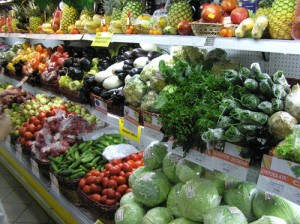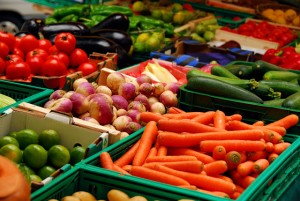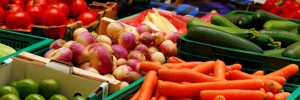The Different Nutrient Content of Vegetables
With few exceptions, unprocessed and fresh vegetables are naturally low in cholesterol, calories (kcal), fat, and sodium. Most vegetables are good sources of carbohydrate (including fiber), vitamins, and minerals – beta-carotene, vitamin C, certain B vitamins, potassium, and calcium . It has been suggested by health researchers that this nutrient combination, in addition to other non-nutritive compounds found in a plant-based diet of vegetables, fruits, whole-grain foods, and legumes (especially soy products), contributes to a reduced risk for certain types of cancers.
Calories (kcal). Most vegetables, particularly the green and leafy varieties, are low in calories (kcal). The high starch content of vegetables such as beets, beans, peas, potatoes, and corn makes them somewhat higher in calories (kcal).
 Cholesterol. Plants do not contain any cholesterol. For example, peanuts are high in fat but do not contain even a trace of cholesterol. Only animals having a liver have the capability of producing cholesterol, as such, only animal products contain cholesterol. However, cholesterol may be added during processing of a plant-based food item.
Cholesterol. Plants do not contain any cholesterol. For example, peanuts are high in fat but do not contain even a trace of cholesterol. Only animals having a liver have the capability of producing cholesterol, as such, only animal products contain cholesterol. However, cholesterol may be added during processing of a plant-based food item.
Carbohydrates. Some vegetables are so high in complex carbohydrates that they can substitute for grain-based starches. Potatoes, legumes, and corn fall into that category. During the ripening process, vegetable sugars convert to starch for storage. Corn, carrots, and peas taste sweeter when harvested early because their sugars have had less time to convert to starches. In fruits, the opposite occurs; starches convert to sugars, which explains why a ripe melon tastes sweeter than an unripe one.
Fat. There are little or no fat found in unprocessed vegetables. The only vegetable foods which contain high level of fat are those processed vegetable oils derived from plant seeds – corn, peanut, rapeseed, cottonseed, safflower, and others. The calorie (kcal) and fat content of selected vegetables are shown below.
Fiber. Many, but not all, vegetables are rich in dietary fiber. Fiber content varies a good deal among plant foods. For example, iceburg lettuce contains only 1 gram of fiber per cup: one would have to consume 20 to 30 cups of lettuce to obtain the recommended 20 to 30 grams of daily fiber, whereas only 1.5 to 2 cups of kidney beans would have to be eaten to obtain a similar amount.
 Vitamins and Minerals. Vegetables are usually higher in vitamins and minerals than fruits. Sprouted beans are high in vitamin C and riboflavin (B2). Dark green, leafy vegetables are good sources of riboflavin (vitamin B2), carotene, vitamin C, and iron. Though 80 percent of the calcium in an average North American diet is derived from dairy sources, the next most important source is green vegetables such as broccoli. However, compounds called oxalates, found primarily in green vegetables, can bind to the calcium, zinc, or iron in these vegetables and prevent the body from absorbing the minerals. Green vegetables are excellent sources of vitamin K and folate, a B vitamin, the need for which almost doubles during pregnancy.
Vitamins and Minerals. Vegetables are usually higher in vitamins and minerals than fruits. Sprouted beans are high in vitamin C and riboflavin (B2). Dark green, leafy vegetables are good sources of riboflavin (vitamin B2), carotene, vitamin C, and iron. Though 80 percent of the calcium in an average North American diet is derived from dairy sources, the next most important source is green vegetables such as broccoli. However, compounds called oxalates, found primarily in green vegetables, can bind to the calcium, zinc, or iron in these vegetables and prevent the body from absorbing the minerals. Green vegetables are excellent sources of vitamin K and folate, a B vitamin, the need for which almost doubles during pregnancy.
Protein. Vegetables are not a complete source of protein as they lack certain essential and important amino acid. The most complete sources of protein in the plant kingdom are the legumes, which nevertheless tend to be low in the essential amino acid methionine. Most vegetables average only about 3 percent protein and are far from complete, so various combinations of legumes and cereals serve as a complete protein and act as a dietary staple for much of the world’s population.
Fruits and vegetables also contain electrolytes such as potassium and sodium, although the amount of sodium in fresh produce is of negligible proportions in the human diet. Canning often increases the sodium content, but lower-sodium versions of many processed foods and beverages are now available on the market.
Phytochemicals. Research now indicates that fruits and vegetables may carry a vast array of phytochemicalsnonnutritive compounds in plants that possess health-protective benefits. Foods that contain phytochemicals, rather than manufactured supplements, are the preferred source. Citrus fruits and berries contain phytochemicals called flavonoids, which seem to interfere with cancer-causing hormones. The cruciferous vegetables as well as tomatoes, strawberries, pineapples, and green peppers contain phytochemicals that appear to inhibit cancer in laboratory animals. Studies on phytochemicals have prompted the National Cancer Institute to recommend an increased daily intake of fruits and vegetables, particularly cruciferous vegetables.
Calories (kcal) and Fat Grams in Vegetables
| Vegetables | Serving size | Calories (kcal) | Fat/grams |
| Baked potato | 1 medium | 57 | 0.1 |
| Pinto beans | 1/2 cup cooked | 116 | 0.4 |
| Sweet potato | 1 medium | 103 | 0.1 |
| Navy beans | 1/2 cup cooked | 129 | 0.5 |
| Lima beans | 1/2 cup cooked | 104 | 0.3 |
| Corn | 1/2 cup cooked | 88 | 1.1 |
| Green Peas | 1/2 cup cooked | 67 | 0.2 |
| Lentil | 1/2 cup cooked | 115 | 0.4 |
| Most other vegetables | 1/2 cup cooked | < 40 | 0.4 |
